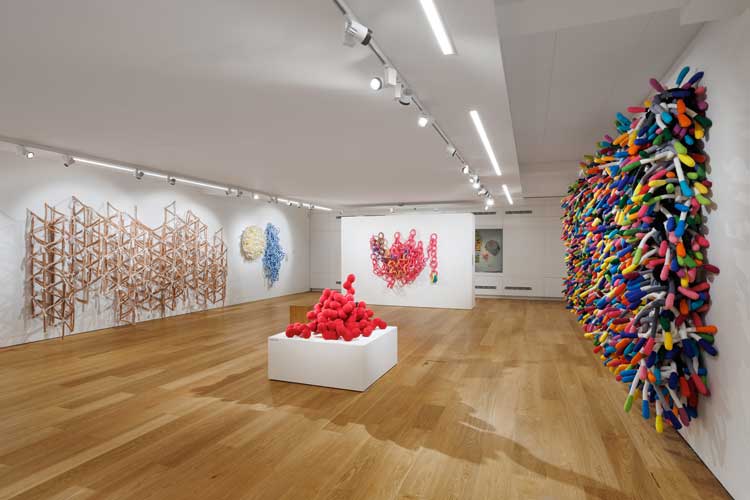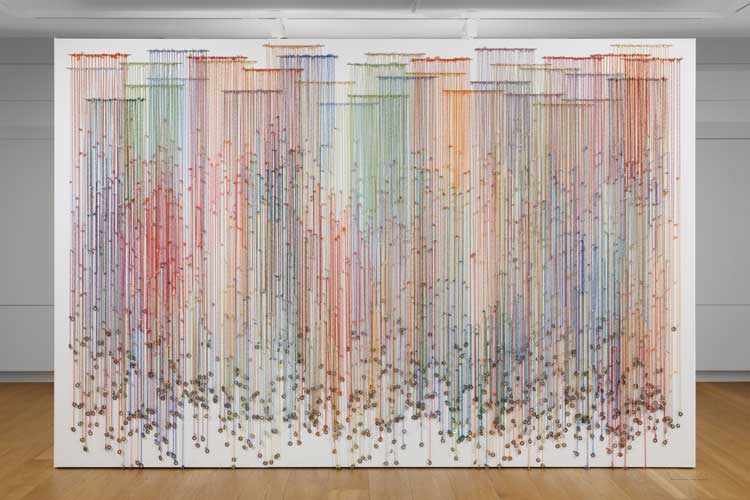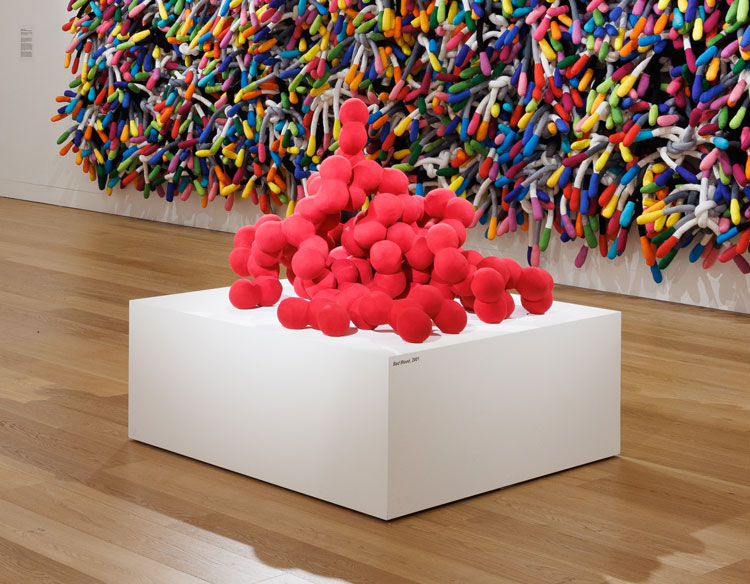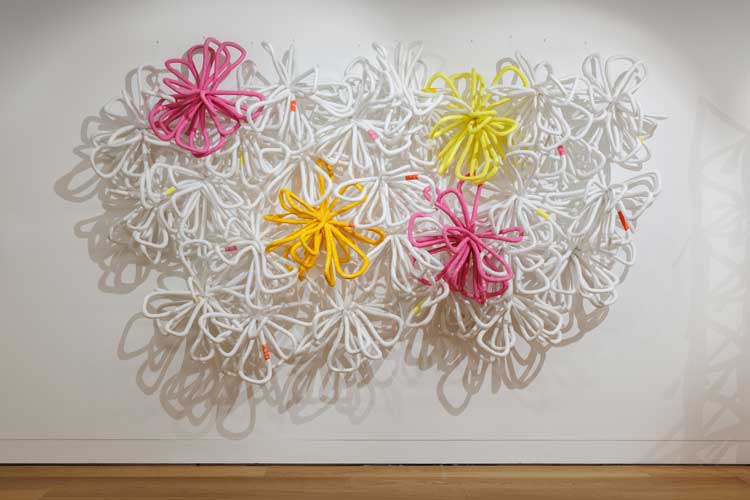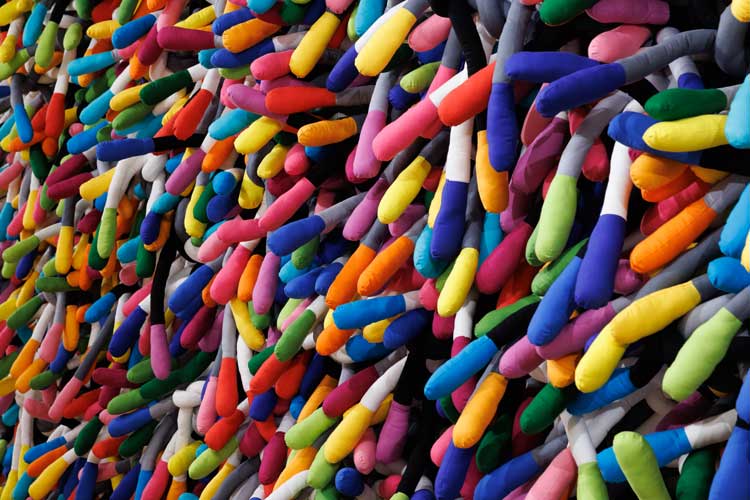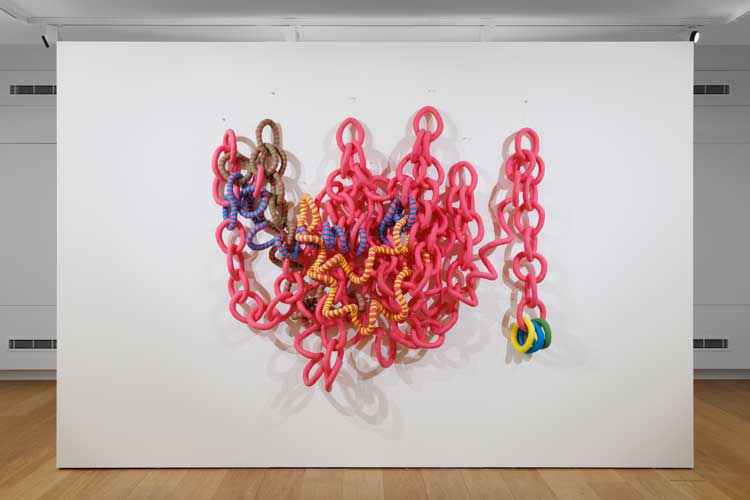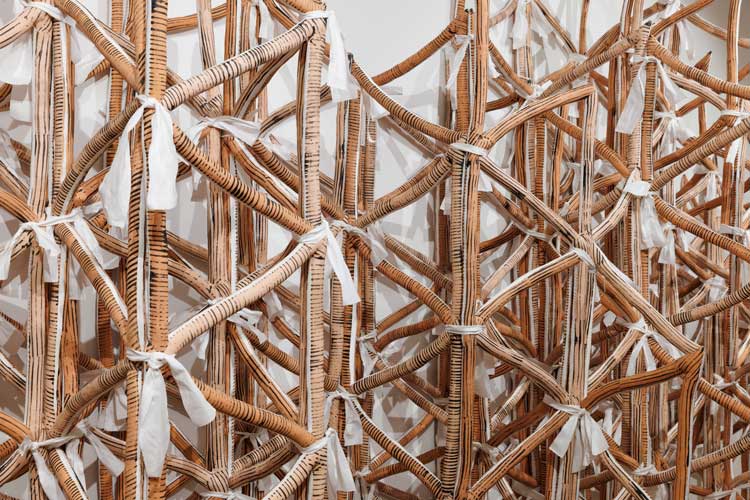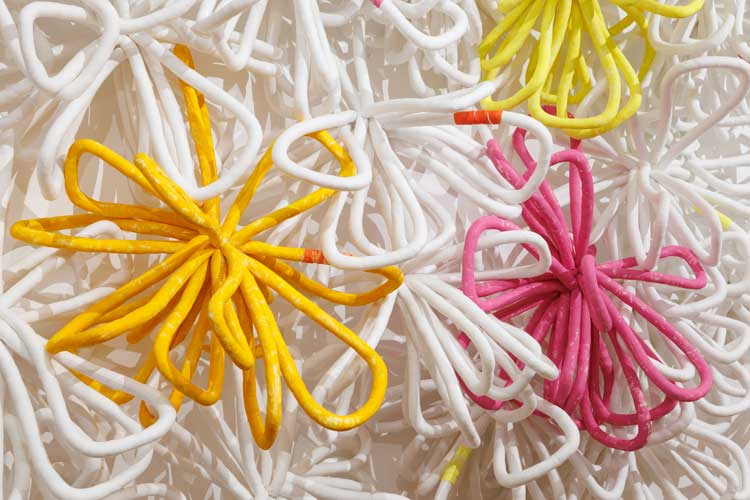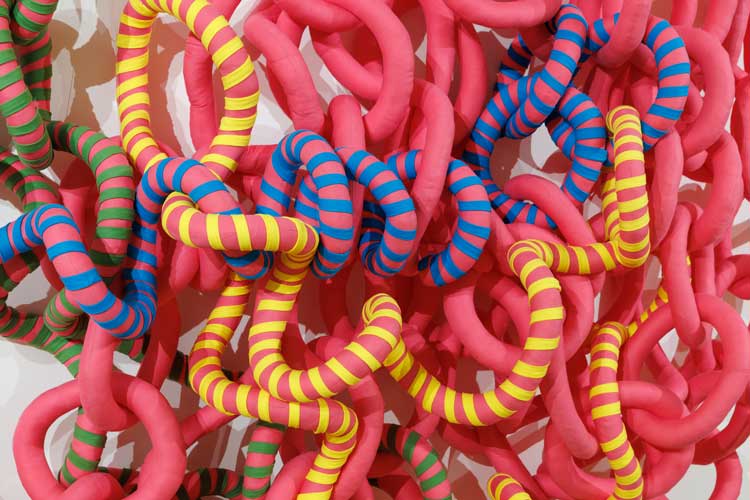

Weston Gallery, St Albans Museum + Gallery
26 November 2021 – 17 April 2022
by ANNA McNAY
I had not been to a museum or gallery for 21 months, so whatever I saw first was bound to have an impact, but boy did Anna Ray’s Fibre and Form, at St Albans Museum + Gallery, pack its punches! I was there off duty, so to speak, to take part in a therapeutic workshop, and, during the lunch break, I wandered downstairs, just out of curiosity, and was met with a wonderland of brightly coloured loops and threads, phallic tentacles, silk chains, tangles, knots and flowers. Talk about therapy! It was as if I had stepped into a parallel universe – one free of all Covid-related cares; through the looking glass; through the back of the wardrobe; or through the curtain – take your pick.
[image2]
I suggest “curtain”, because the first piece to really capture my attention was Offcut-ends (2019), a hanging array of multicoloured strands of Aquafil yarn, weighted down with oak and stainless-steel washers, creating a curtain against the white gallery wall (think in terms of one of those light, summery, beaded ones, not one of a heavy, wintery, velveteen pair, to be drawn closed to keep out the dark and chilly nights). The work was developed during a three-month residency at Forbo Flooring Systems in Lancashire, and Ray took inspiration from the colours and yarns used in the manufacturer’s carpet-top cloth, using its heat-sealing process to “tuft” continuously from one colour to the next. The choice to display this – and, indeed, all her works – against the wall is deliberate. Ray explains: “As a dress needs a body to take its shape, so my work needs the surface of the wall to cling to.”
[image3]
Although Offcut-ends does indeed “cling”, many of Ray’s other works seem to be bursting forth and attempting to break free from their pristine surfaces. As Ann Coxon, in her essay to accompany the exhibition, writes: “Placing them centre-stage on the gallery wall, she forces us to reconsider what is usually seen as marginal, additional or peripheral – the trim becomes the object itself.” Indeed, the textiles take on a life of their own; tapestry and knitting become three-dimensional; embroidery acquires surface depth. The works are playful, joyful, heart-warming, and yet there is simultaneously a subtlety and minimalism to them, echoing the soft, phallic sculptures of Yayoi Kusama, but also, according to Ray, influenced by the engagement with the feminine, the psychological, the bodily and the haptic of Louise Bourgeois, Sophie Calle and Helen Chadwick. A clear example of this is Bad Blood (2001), a response to the cells inside the human body, their processes, energy and sense both of natural order, but also natural chaos.
[image5]
A key work that cannot be missed, stretching nearly the full length of a side wall, is Margate Knot (2016) (originally produced for the Turner Contemporary exhibition Entangled: Threads and Making), which comprises 2,000 multicoloured sewn elements, tied together to create a three-dimensional tapestry. It is like an exploding rainbow, albeit one made up of 16 colours, each referencing something specific to the seaside in Margate: the red harbour marker posts; the wine-coloured and acid-green seaweed; the colours of wildflowers growing up chalk cliffs; the brightly painted beach swings; a turquoise plastic ice-cream sculpture; the buoys and the knotted ropes that decorate the harbour arm. Developed from Knot (2007), further inspirations for the methods used here include the underwiring of bras and the children’s game pick-up sticks. Ray truly is a magpie at every level.
[image6]
The nearby Ribbon Chain (2019) could almost belong in this Dreamland-esque vision of Margate’s bay, attached, perhaps, to a heavy anchor. Versatile in its display format – coiled or uncoiled; here something in between – the tangled chain comprises handmade magenta silk ribbons wrapped around one continuous length of linked forms and open coils. Ray speaks of her process, saying: “I often pick up a piece of fabric and simply begin manipulating it and then see where this ‘play’ takes me.” This sense of exploration resounds throughout the exhibition and invites the visitor even deeper into the artist’s world – or, indeed, restokes their own fading artistic embers.
[image7]
Another large work, also with something of a nautical theme, is Mesh (2020), commissioned especially for this exhibition, and, in contrast to the other pieces, largely monochrome. The inspiration here comes from the boning of clothing in the 1700s, with the sculptural elements stacked, slotted and tied in place in situ, like geometric tessellations. Ray describes this versatile work, which can be shown flat, as it is here, or built into a cage, as “a metaphor for our current, constrained situation, and the potential of our eventual release”.
[image4]
Rosette (2021), also made for the occasion, reflects on Ray’s Huguenot ancestors, the Hoinvilles, who were silk weavers and manufacturers of fancy trimmings (passementerie) in Spitalfields in east London in the same era. Here, Ray has scaled up a collection of flower-like forms, or potential piece of passementerie, using white cloth, and embellished them with ribbons cut and hand-painted from the same fabric. In her practice, form and structure, typically explored in white, frequently precede colour and pattern; in this instance, Ray fell in love with the “emotional lightness” of the white cloth against the white wall and the inherent sense of a new beginning. Certainly, there are correlations between the muted quality, the historicity and the references of these two pandemic-era new works.
Pattern, when it is added, however, plays a significant role in Ray’s practice, and she speaks of its “unique power to hold your attention visually and psychologically”, as well as to “shift” energy. Vitrines at either end of the gallery show smaller works, test pieces, sketches and tools, offering insight into the artist’s mind. A lot of effort also goes into researching the exact qualities of the materials Ray works with, their subtleties, how they work alongside each other, and, of course, their overall aesthetic. In conclusion, Ray summarises: “I want my pieces to float, gather or fall naturally – to be themselves, to become exquisite.” And become exquisite they most certainly do. Exquisite, enchanting and engrossing. This uplifting show was well worth the (in my case, at least, very long) wait!
